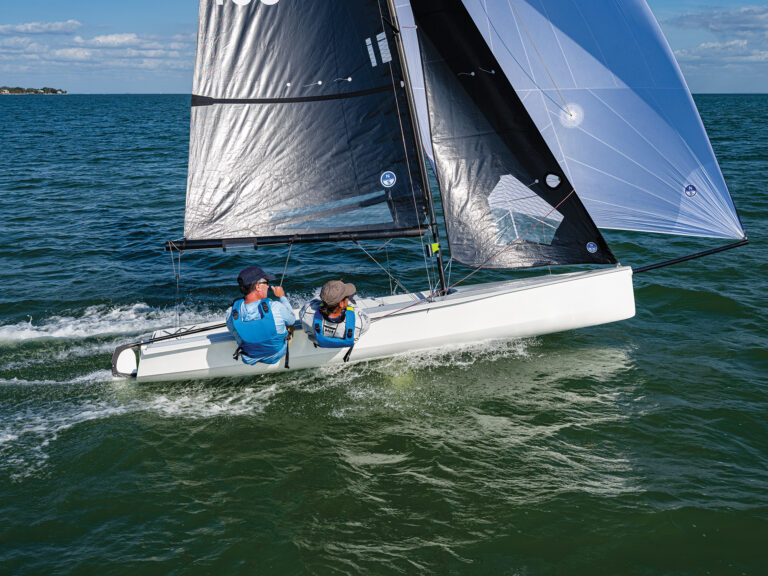From year to year, and across many different boats, the language of sailors changes to reflect the commands of the skipper, the needs of the crew, the encouragement of the tactician, and the emotions of the moment. New words and expressions are used every season. Amazingly, these phrases quickly spread all over the world thanks to globetrotting racers, instantaneous Internet reports, and onboard television microphones. But the slang used on many boats today is sometimes difficult for new crewmembers to understand, which offers yet another reason to practice and, as necessary, explain the terms commonly used before a race so everyone can get into an easy, flowing groove. Over the past several months I placed cameras on board a wide variety of boats, collecting footage for several television shows. Listening to more than 100 hours of recordings provided me with fresh evidence that communication is a critical performance factor. Simply put, the words you use count. The old expression, “It’s not what you say, but how you say it,” certainly applies on any raceboat. Generally, quiet boats seemed to do better, and I can guarantee you that yelling rarely works. During the most intense moments of a race, such as rounding a mark, approaching the starting line, or crossing another boat, the best, most disciplined crews are quiet. One steady voice provides the guidance and gives a boat confidence. I enjoyed hearing tacticians give a brief forecast of what was about to happen, and then adding a little inspiration. As an example, here’s a conversation we recorded on a successful Farr 40: “In 45 seconds we’ll drop the chute.” “Keep the bow down after rounding. [A powerboat has just thrown up a big wake.] We don’t need to tack immediately.” “The wind is up, we need early, hard hiking.” “You’re the best!” “Let’s do it!” One person spoke this stream of consciousness in 14 seconds. Thirty seconds later the boat made its turn, and I heard five voices in a kind of cadence during the actual leeward mark rounding: “Drop.” “Turning.” “Clear to tack.” “Waves in four.” “Nice job!” That was it. The tactician briefed everybody just before the maneuver with all the pertinent information: the time until dropping the spinnaker, the need to sail fast and not point due to approaching waves from a powerboat; letting the crew know they were not in a hurry to tack, and that the windspeed had increased since the last upwind leg, therefore crew weight on the side would help stability. And finally, some encouragement, “You’re the best” along with the command to initiate the turn. “Let’s do it.” During the mark rounding itself, several members of the crew used short comments to let other crewmembers know when progress was made. “Turning” (the helmsman turns the wheel to round the boat up). “Clear to tack” (the windward sail trimmer reports that the windward jib sheet is clear and the boat could tack at anytime if needed). “Waves in four,” was called by a rail rider assigned to tell the helmsman about waves. In this case the impact was 4 seconds away. The helmsman keeps the bow down for speed. “Windspeed up-we need early hiking,” lets the crew understand they need to sprint to the rail. “Nice job!” the tactician declared. This short, verbal, pat on the back signals that the mark rounding is finished, and we are now in the next phase of the race. The recording from a mid-size handicap keelboat had a much different dialogue: “Who’s got the halyard?” “Get the outhaul!” “What jib is that?” “Pass me my foul weather jacket!” “Hey, no room!” “Drop it, drop it!” “Get it out of the water!” “You’re spinning out, man!” “Come on!” “How’s the jib lead?” “Move it back.” “We need to tack.” “We can’t?” “Hurry up!” Well, you get the drill. On this boat the tactician was micromanaging every action, it sounds as though the crew is late with a couple of key responsibilities, and the decibel level was definitely amplified. Everyone on board this boat was on edge and unsure of what needed to be done. That they were well back in the pack is not surprising. The tone on our handicap racer is obviously different than that of our Farr 40 team, but another thing to note is how experienced teams use concise language. To a non-sailor, the phrases sound clipped, but champion teams clearly talk through maneuvers and sailing routines. They do so during practice times as well. During scheduled practices, reviewing how to communicate helps everyone understand how to work together come race time. It’s important to give orders in precise terms. For example, “Ease the jib sheet three inches” is easy to understand. It’s hard when a trimmer hears, “Ease the jib a tad.” Does a tad equal one, two, or six inches? One trimmer, I overheard, noted that it took him a long time to understand the difference between “a tad,” “a little,” “heaps,” “a bit,” or “a fraction.” Being precise prevents confusion. We found a perfect example of this when reviewing footage from last year’s college sailing national championships. Here’s a clip of one conversation we recorded between an all-American skipper and crew: “He’s going to dictate our wing.” “Wing.” “Jibe.” “Good.” “Aft.” This was all the conversation the microphone picked up on an entire leeward leg. The skipper and crew had been racing together for months and knew each other’s actions. “He’s going to dictate our wing” means when the boat behind bears off and wings his jib, we will do the same to cover. “Wing” meant trim the jib to the windward side. “Jibe” says we’re turning now and it’s time to switch the jib to the other side of the boat. “Good” is different, a brief moment of encouragement. Then it’s back to business: “Aft” means move weight aft to get the bow up. Another collegiate racer couldn’t stop talking, and at high volume at that. The discussion ranged from their bad luck, to the weird way the leading skipper was sitting in his boat, to the night’s festivities. Which of these teams do you think ended up at the top of the standings? And speaking of useless dialogue; one keelboat crew filled one of my tapes by having a lengthy discussion on mutual funds. This was during a race! These crewmembers were all hanging around the wheel. In 20 minutes of the recording there was not one word about the boat’s performance. To avoid being a spoilsport, the best way to stop a distracting conversation is to redirect by prompting for sailing-related comments, speed ideas, or at the very least a suggestion that the conversationalists move to another part of the boat to talk. As you might expect, I did hear plenty of salty language on the tapes, which required lots of editing for the shows, but there were important verbal passages. Tacticians were at their best while giving options. It makes everyone think through situations. Crews gained confidence when accurate reports were given. Discussion should be done while sailing in a straight line; crews need to concentrate on their jobs during maneuvers. One thing that was particularly bothersome on the tapes were crews yelling at other boats. People remember this kind of unfortunate behavior-and it never helps a crew’s own performance. The non-stop talker eventually gets tuned out. The best time to give advice is when a skipper asks for it, but sometimes you have to speak up anyway. Whenever you open your mouth, make your words count-when they’re constructive, they make a difference.









